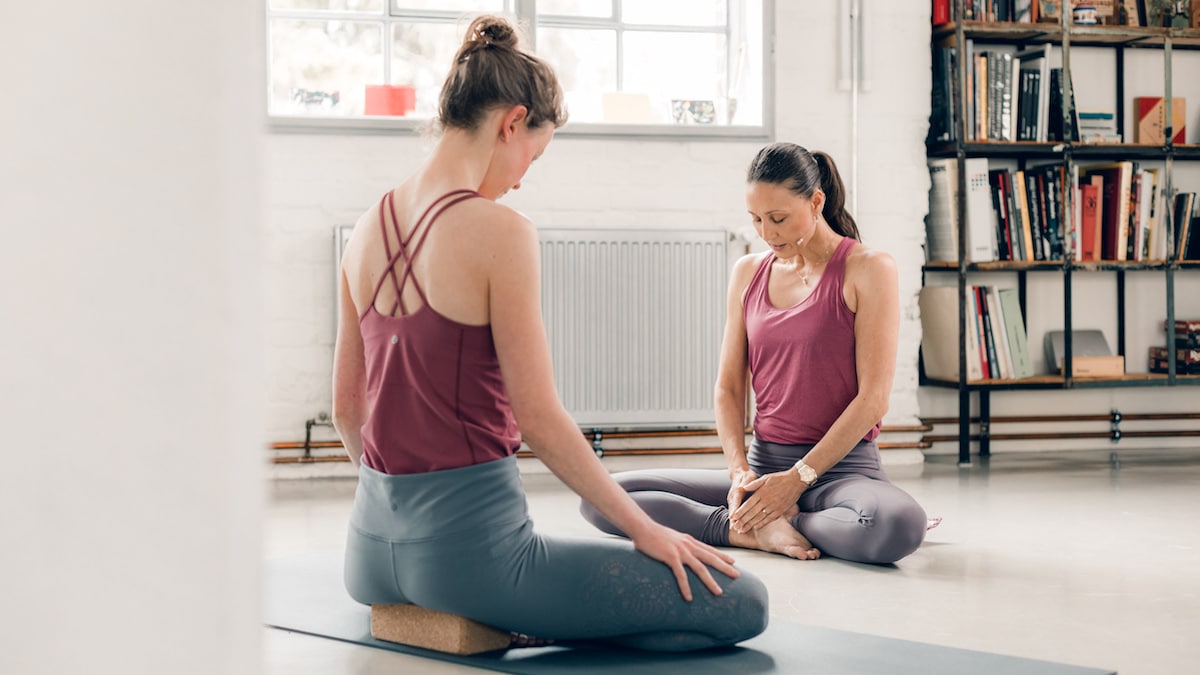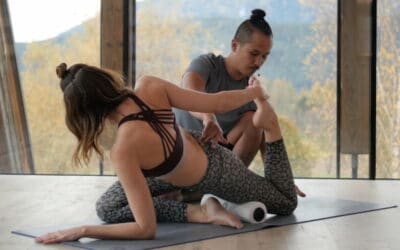When you ask yoga teachers around the globe which part of their work is the most time-consuming, they will certainly answer in unison: creating a yoga class sequence.
As yoga teachers are constantly struggling with sequencing new yoga classes that make them stand out in the yoga crowd, this can be an exhausting and daunting task.
Creating a yoga sequence is quite an art – and crucial to the success of a yoga class. This article is intended to assist and support you on your journey to creating great sequences.
Let’s explore:
- 1. What is Sequencing?
- 2. Why Do You Need a Yoga Class Sequence?
- 2.1. What About Creativity?
- 2.2. Should I Use a Set Template
- 2.3. Stay Flexible
- 3. What Makes a Great Yoga Class Sequence?
- 3.1. Characteristics of a Great Yoga Class Sequence
- 3.2. Questions to Help You Build a Great Yoga Class Sequence
- 4. Different Ways of Intelligent Yoga Sequencing
- 4.1. Set Yoga Class Sequence
- 4.2. Sequencing Toward a Peak Pose
- 4.3. Sequencing Around an Action
- 4.4. Therapeutic Sequencing
- 4.5. Creative Yoga Sequencing
- 4.6. Sequencing Around a Spiritual Theme
- Bonus: Free Sample Yoga Sequences for Teachers
1. What is Sequencing?
Sequencing means to build a complete and effective yoga class that allows students to move from one place and one pose to another in a simple yet safe manner.
Creating yoga class sequences requires yoga teachers to anticipate, accept and honor the conditions, abilities, and reality of the students in class, and to present yoga to them in a way that works for them. It’s important to acknowledge where the students are. Proceed from there, rather than rushing through different poses at the expense of stability and ease.
A sequence is the connection of different poses, movements, or asanas. The smallest sequence is a Vinyasa, where we consciously connect body, mind, and breath with one another by using adequate transitional movements between poses. Actually, even the simplest movements in yoga are Vinyasas. Think about, for example, the action of raising the arms from Mountain Pose (Tadasana) overhead into Urdhva Hastasana.
In this kind of sequence, the breath acts as a guide. If breathing becomes difficult, this is a clear sign to slow down or reduce the intensity of the practice. Thus, the breath enables practitioners to practice with more awareness, steadiness and ease.
“We develop the yoga practice breath by breath, step by step, sequence by sequence, class by class, each breath and movement drawing from what came just before just as it prepares us for what may come next.”
2. Why Do You Need a Yoga Class Sequence?
With so many different yoga styles available, each of them claims to offer the best, most effective, healthy, or otherwise optimal approach to sequencing a yoga class. However, the truth is that there’s no completely correct or incorrect sequence.
It rather is the case that the question of whether a yoga class sequence makes sense mainly depends on the students practicing. Different people in different life situations, with different abilities, need different approaches on how to sequence a yoga class.
On the one hand, this gives you as a yoga teacher enormous freedom in creating and building yoga sequences. On the other hand, this freedom also implies the responsibility for ensuring that your chosen sequences are safe, healthy and appropriate to the students at hand.
2.1. What About Creativity?
The main focus should be on developing sequences for yoga classes that are structured and coherent. Your yoga classes should provide meaning and transformative potential to the students. This requires yoga teachers to consider and apply everything they have learned about yoga, including anatomy and philosophy, asana and pranayama, self-expression and self-actualization.
However, many yoga teachers do not step in front of their students with a fixed yoga class sequence prepared. Instead, many yoga classes reflect random creativity. This approach certainly gives you the freedom to better adapt to the students’ condition and situation in any given class. It’s also a great way to approach your own yoga practice.
However, if you want to build a yoga class for others, you run the risk that this random approach leads to confusion, difficulty, or even injury in the students.
2.2. Should I Use a Set Template?
In contrast random creativity, there’s also is a wide variety of classes that are based on some kind of template found in a book, teacher training manual, or website or that have been adapted from other yoga teachers’ classes.
These templates can certainly be helpful to get started in creating your own well-rounded classes. However, beware not to apply the template or observed yoga class sequence in an off-the-rack manner. You risk teaching it to students or in settings for which it is not appropriate.
“While creativity is beautiful, it is ideally expressed in keeping with the basic sequencing.”
Another mistake you need to avoid when using pre-designed classes is to change the sequence in a way that it does no longer fulfill its intended purpose of addressing movement or flexibility. You may unintentionally and unconsciously change the energetics of the sequence or any other essential aspect of the original sequence that made it work. ‘Yoga Sequencing’ author Mark Stephens recommends: “While creativity is beautiful, it is ideally expressed in keeping with the basic sequencing”.
2.3. Stay Flexible
However, despite creating and preparing sequences in advance, stay flexible. You need to make sure that your yoga classes make sense with regard to the students in front of you. When you vigorously stick to a predetermined sequence, you run the risk of teaching a class that is too hard or too easy, or otherwise not suitable for that particular class on that particular day.
Always bear in mind that it’s essential to build yoga sequences with a systematic method. It should integrate body, mind, and breath by gradually moving into a deeper practice.
3. What Makes a Great Yoga Class Sequence?
What does that mean for you as a yoga teacher? Your role in yoga sequencing is to intelligently plan the course on the basis of the condition and situation of the students in class.
At the same time, you have to observe and communicate with your students so that you know when they have adopted and internalized your teachings with permanence and ease.
And finally, you have to provide clear guidance, motivation, and inspiration along the journey.
Remember that you want your students to leave their yoga mat feeling more integrated than before the class.

As a yoga teacher, you want your students to leave your class with a better feeling. Photo: TINT Instructor Barbra Noh.
3.1. Characteristics of a Great Yoga Class Sequence
There are five key characteristics any yoga sequence should have. Make sure your sequences are informed, effective, efficient, beautiful, and integrated.
Informed means to use correct information and knowledge regarding the elements of the practice you’re doing or teaching.
Effective means that the sequence is successful in achieving the aim intended for the practice while at the same time being safe, balanced, and healthy.
Efficient: Creating an efficient sequence means that you guide your students toward the intended aim in the most simple way. This will give your students the opportunity to gradually transition into a deeper and more rewarding yoga practice.
Beautiful: When the practice reflects the students’ inherent nature as a beautiful being, yoga becomes a source of beauty making it an elegant and deeply satisfying practice that just feels right.
Integrated: Finally, any sequence should be a complete and integrated practice that takes into account the whole experience.
You want to build yoga sequences that embody all of these qualities. Although each class may have a more specific focus on one or more of these areas.
3.2. Questions to Help You Build a Great Yoga Class Sequence
The first step is always the hardest. Where to start when developing a sequence for your yoga class? You now know what qualities make a great yoga class sequence. As a next step, ask yourself a few simple questions and let them guide you along your preparations:
1. What is the time of the day you want to teach the sequence (e.g. in the morning vs. in the evening)?
2. Which season, month, or phase of the moon we are in (e.g. summer vs. winter, high vs. low energy levels)?
3. What is happening in the world or in your life you can relate to?
4. Is there any (spiritual) theme (e.g. Yama/Niyama, Chakras, gratefulness, mindfulness) or inspiring quote you would like to focus on?
5. How much time do you have?
To make sure that you consider your students’ needs when planning your class, also reflect upon the following questions:
1. What would serve my students best?
2. What would I like the students to walk away with?
3. What would my students enjoy?
4. What main feeling would I like the students to experience in my class?
In the beginning, it may be helpful to take the time and write your answers on a piece of paper. You will notice that this makes planning much easier. Once you’ve found the answers, you can go into the details of your yoga sequencing. Start sketching out the order of the asanas, movements, and other practices you want to include into your yoga class sequence.
However, you have different options and ways to sequence a yoga class, which we will explore in the following section.
4. Different Ways of Intelligent Yoga Sequencing
Your goal should always be to sequence your yoga class intelligently. Intelligent yoga sequencing is the art of creating a class that builds towards a specific intention in a logical manner. The order of the yoga poses should be designed to reduce tightness and strengthen weaker parts of the body. At the same time, it should uplift the heart and free the spirit.
While there are many approaches to sequencing a yoga class, we focus on the following 5 ways of yoga sequencing:
1. Sequencing towards a peak pose;
2. Sequencing around a specific action or detail of alignment;
3. Therapeutic yoga sequencing;
4. Creative yoga sequencing;
5. Sequencing around a spiritual theme.
“Intelligent Sequencing is the art of creating a class that builds towards a specific intention. The order and arrangement of asanas is designed to open up tightness and strengthen weakness in the body, uplift the heart and free the spirit.”
4.1. Set Yoga Class Sequence
The 5 ways of yoga sequencing are intended to help you create a new sequence for every yoga class. Another option is to teach the same set sequence again and again in every single session.
In some yoga styles and traditions, such as Ashtanga Vinyasa or Bikram, the order of poses is set. It is the same order in every class no matter where in the world you practice this style of yoga.
The benefit of a set sequence is that the practice is a reflection of the practitioner. This is because the only thing that changes from one session to the next is the condition of the practitioner. The difference between two practices is not the sequence itself, but rather the person doing it. This gives them the opportunity to gain a deeper insight into their personal progress and development. This enables practitioners to better experience the self-transformation through yoga.
Another benefit of doing set sequences is that you know where you’re heading. There are no surprises, no unforeseeable challenges and you can exactly determine your level of fitness.
However, one issue to be aware of when doing set sequences is the potential strain caused by doing repetitive actions. When you repeat the same monotonous movement again and again, the same muscles, joints and ligaments are used. This also prevents the body from learning and adapting to new stimuli.
4.2. Sequencing Toward a Peak Pose
One way to create a new sequence for your yoga classes is sequencing toward a peak pose. The peak pose is the most challenging pose in the class that requires thorough preparation so that the body is
1. strong and stable enough,
2. flexible and open enough, and
3. students have gained the knowledge and body awareness that is required to perform the peak pose.
To create a sequence that adequately prepares the body for the intended peak pose, there are three points to consider:
1. Which part of the body needs to be stabilized or strengthened?
2. What kind of flexibility or openness is required to do this pose?
3. What do your students need to know or understand? Or in other words: What are the most common misunderstandings or misalignments in this pose?
Examples for typical peak poses are Crow or even twisting arm balances, which you can practice with Mathieu Boldron on TINT. King Pigeon is another very popular peak pose that requires a well-rounded preparatory sequence. Matt Giordano created a 5-part workshop on TINT that prepares your body for this exact peak pose.
See how Mathieu Boldron builds a yoga sequence toward twisting arm balances.
4.3. Sequencing Around an Action
Another approach to building a yoga class is sequencing around and action or specific detail of alignment. The goal of this yoga sequencing technique is less to achieve a particular yoga pose. Instead, the focus is on educating students and help them deepen their awareness and understanding of a particular action or detail of alignment.
When choosing this yoga sequencing technique, always start with an asana that is very simple and familiar to your students. In that way, it’s easier for them to apply the required actions in a pose they already know. So there will be no doubt in their mind of how to do it.
You then gradually add different poses where the students have to apply the same actions. You can even use the same wording in your instructions. This gives students the opportunity to become more and more skillful and familiar with the actions. They will thus get to know these actions and how they feel in their bodies in different poses.
It’s a good idea is to choose an asana where you experienced some kind of aha effect yourself. Use a pose where applying these actions just opened up the pose for you and improved your practice. This gives you the opportunity to share your own experiences with your students, making your teaching more authentic.
To get an insight into sequencing around specific actions, check out Desirée Rumbaugh’s Strong & Mindful Yoga on TINT.

Get some inspiration how to sequence around an action in Desirée Rumbaugh’s Strong & Mindful Yoga.
4.4. Therapeutic Sequencing
A rather skillful approach to yoga sequencing is therapeutic sequencing. This means designing a class that is aimed at improving or alleviating pain, discomfort, or injury in the bodies of your students. The most common examples are lower back issues, neck and shoulder pain, shoulder injuries, or even recovery from surgery.
This yoga sequencing technique requires a thorough knowledge of anatomy and biomechanics. It’s important to know what actions and poses in yoga can help somebody with their specific issues or problems.
In general, in a therapeutic sequence, the focus should be on strengthening and stabilizing the weaker parts of the body. At the same time, work opening up and freeing the blocked or stiff parts of the body.
It’s also helpful to work with a specific template of how to organize the body. You can learn more about this template in Barbra Noh’s workshop Therapeutic Alignment Immersion on TINT.
On TINT, you can also find various therapeutic sequences that you can practice and familiarize yourself. You may then teach them even if you don’t have a lot of knowledge about anatomy, biomechanics, and therapeutic yoga. There’s, for example, Mirjam Wagner and David Lurey’s 10-part workshop Yoga for Shoulders & Upper Spine. This workshop alternates between Yin and Yang approaches to alleviate pain in these areas. Young Ho Kim also created the 4-part workshop Yoga for Neck & Shoulders. He exactly focuses on opening blocked parts and strengthening weaker parts of the body.
Try a 20-minute yoga sequence for neck and shoulders with Young Ho Kim.
4.5. Creative Yoga Sequencing
Creative yoga sequencing is your chance to explore a playful approach and have fun with different transitions. Transitions are the way we connect one asana or pose with the next to create a seamless flow of movement.
Rather than working with specific guidelines, this yoga sequencing technique is aimed at setting your mind free. You can simply put on some music and follow your intuition. Trust that your instincts will guide you while you explore different ways to connect one asana with the next.
Be playful and creative instead of trying to figure everything out rationally. Rather move and feel and remain curious about different directions you may take. Maybe you want to initiate a transition from a part of the body you usually don’t think about.
“Be playful and creative and not too much up in your head trying to figure everything out rationally. Instead, move and feel, follow your intuition. Be interested and curious about different directions you may take.”
With creative yoga sequencing, the approach is more choreographic. It’s more artistic and less goal-oriented toward a certain pose or particular detail of alignment. It’s less technical but rather free flow and enjoyment.
This approach actually is the foundation of Inside Flow. This is a yoga style in which music drives the yoga classes and frames the whole sequence. In the end, you do have a set sequence or choreography that guides the class. There are several different Inside Flow classes on TINT. So you can experience this driving force of music and intuition yourself.
Inside Flow is a way of creative yoga sequencing, allowing for self-expression of the practitioners as you can see from our Inside Flow flashmob.
4.6. Sequencing Around a Spiritual Theme
The most advanced way of yoga sequencing is sequencing around a spiritual theme. This is because this technique requires you to be already solid and confident with yoga sequencing in general. So, it’s best to have mastered the other four ways of yoga sequencing before approaching this technique. Possible spiritual themes to base your sequence on could be the 7 Chakras or the 5 Elements of Nature.
If you’re looking for some inspiration for a spiritually-themed sequence, check out Cristi Christensen’s workshop Soul Fire Elemental Activation. In this workshop, she created a Vinyasa sequence, a Pranayama and Mudra practice for each of the 5 Elements. This gives you a good idea for a well-rounded spiritual yoga practice.
We also have a Chakra Awakening Body & Soul workshop on TINT. Faith Hunter takes you on a carefully designed journey through the 7 Chakras.
Explore how Faith Hunter builds a yoga class sequence around the First Chakra.
These are only two examples of spiritual themes on which you could base your yoga class sequence. You can find a wide variety of other possible themes in traditional yoga writings such as Patanjali’s Yoga Sutra or the Upanishads. Make sure you find something you can relate to and that resonates with you. This will make your teaching most authentic.
If you want to dive deeper into the topic of intelligent yoga sequencing and the art of teaching in general, we have something for you coming up. Barbra Noh, founder of Strength & Grace Yoga and certified Anusara Yoga teacher, has created a new online teacher training on TINT Academy. In The Art of Teaching, you will gain in-depth knowledge about teaching skills, yoga sequencing, and what it means to be a great yoga teacher.
Learn how to become an even better yoga teacher in Barbra Noh’s The Art of Teaching.
Bonus: Free Sample Yoga Sequences for Teachers
So much for the theory. Surely, you’re now eager to start building your own yoga class sequences and put your newly acquired knowledge into practice.
However, if you still need some assistance to start off, we’ve got you covered. In our TINT Magazine, you can find an array of inspiring articles that provide you with sample yoga sequences for teachers. There are different topics such as yoga for stress relief, yoga for beginners, or a yoga class sequence focussing on twists.
Apart from that, we have created a free ebook for you that contains a collection of ready-to-use yoga class plans. Use them as inspiration or guideline when preparation time is short. You can also use them when you’re just getting started in building your own sequences.
And don’t worry: Using ready-made sequences is not cheating – it’s intelligent assistance.
Header picture: TINT Instructor Barbra Noh. Photograph by TINT.
Resources:
- Mark Stephens – Yoga Sequencing: Designing Transformative Yoga Classes
- Barbra Noh – Strength & Grace Yoga: 100 Hour Advanced Teaching Skills





